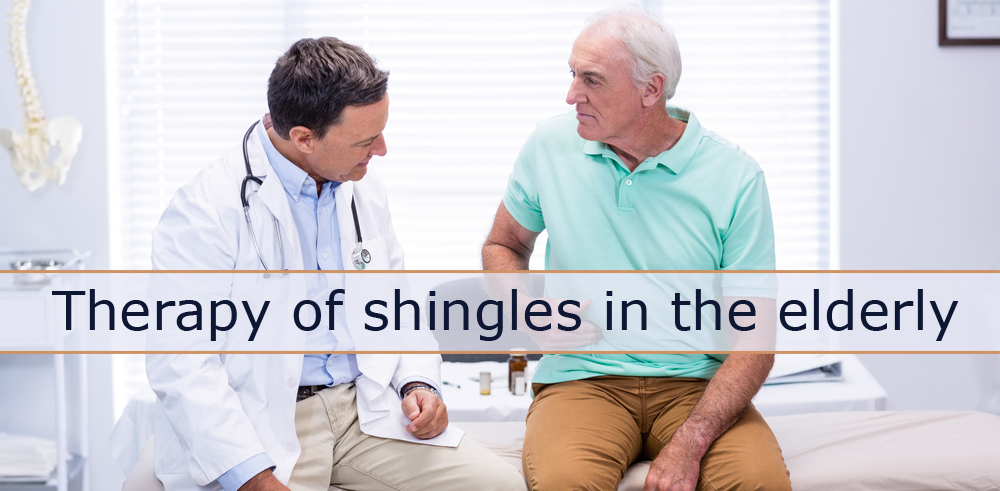How to Relieve the Pain after Shingles in the Elderly?

Shingles is the pathology of viral genesis, which develops when a herpes virus of type 3 enters the body. The disease is characterized by a severe chronicity with seasonal flare-ups (most often in the fall and spring). In some cases, the incubation process may take several years. The disease does not develop in people with strong immunity, as the cells of the immune system suppress the activity of the viral agent. If the defenses of the body are weakened, there is a marked symptomatology and a characteristic pain syndrome. The majority of cases are people over 45 years old and elderly patients – they have a particularly difficult pathology, as not all drugs are suitable at this age.
Therapy of shingles in the elderly
Therapy of shingles in elderly patients should be selected by a specialist taking into account individual factors and the general condition of the patient, as well as assessing the possible risks and consequences.
When choosing a therapeutic tactic, the age of the patient, the state of health, the presence of chronic pathologies, and other factors that may affect the safety or effectiveness of treatment are taken into account. Therapy in patients older than 55 years is aimed at the following goals: suppression of the activity of the virus;
elimination of pain syndrome;
reduction of intoxication and improvement of general well-being;
restoration of the body’s defenses.
Medication Therapy
The main group of drugs used to treat herpes in the elderly is antiviral drugs. They destroy the protein coat of the virus, inhibit its activity and prevent the spread of infection to internal organs. Antiviral interferon-based medications will help not only to destroy the virus, but also to strengthen immunity by stimulating the development of its own interferon.
When treating herpes in the elderly, outdoor walks, diet, and vitamins for raising the immunity are very useful. It is necessary to avoid meeting with patients so that there is no relapse: the transmission paths are contact and airborne. Infection can be transmitted through clothes and by air.
How to relieve pain after herpes zoster
It is important to know that the development of postherpetic neuralgia is caused by the accumulation of type 3 herpes in the peripheral nerves, closer to the muscles and skin. Its main symptom is an acute pain of a pulsating or cutting nature. Often it is the touch of the hands or clothing to the affected areas that leads to an augmentation of pain. On average, the duration of postherpetic pain is from 2 weeks to 2 months, in some patients – up to a year.
Please note that the main method of treatment of postherpetic neuralgia is the relief of pain.
To date, the following drugs are used to combat the postherpetic neuralgia:
- anticonvulsants;
- tricyclic antidepressants;
- patches with lidocaine;
- opioid analgesics.
Conventional analgesics and non-steroidal anti-inflammatory drugs are ineffective in combating neuropathic pain. The most effective are anticonvulsants.
Anticonvulsants in treating PHN
The most commonly used drug of this group is Gabapentin (Neurontin). A feature of the use of gabapentin is the need to titrate the dose to an effective dose. It looks like this: on the first day of intake, the dose is 300 mg 1 time in the evening; on the second – 300 mg in the morning and in the evening; on the third – 300 mg 3 times a day; on the fourth, fifth, sixth day – 300 mg in the morning of, 300 mg in the afternoon, 600 mg in the evening; on the seventh, the eighth, the ninth, the tenth day – 300 mg in the morning, 600 mg in the afternoon, 600 mg in the evening and so on. The effective dose is 1800-3600 mg/day. When the pain disappears, a person should take a maintenance dose of about 600-1200 mg/day. Neurontin is very well tolerated, rarely causes side effects (dizziness, drowsiness), which is important for older people who have comorbidities.
Postherpetic neuralgia refers to those diseases that are easier to prevent than treat. Of course, this is not always possible, but the timely treatment of herpes zoster in most cases helps to avoid this painful complication. It should also be remembered that postherpetic neuralgia often ends in recovery and very rarely persists for many years, so when symptoms of postherpetic neuralgia arise, one should not despair. Time and competent treatment will do their job, and the disease will recede.